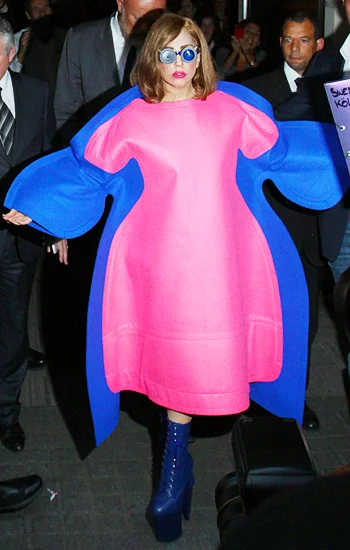The Costume Institute of the Metropolitan Museum of Art announces next year's Met Gala theme.
Read MoreCandice at the MET: A Case for Classics
MET Gala 2017 brought about many buzz-worthy looks (think Rihanna's Comme des Garçons confection, Kendall's La Perla silk-crystal creation, P. Diddy's Rick Owens suit...) as designers and celebrities grappled with this year's theme: "Rei Kawakubo/Comme des Garçons: Art of the In-Between".
However, within the aesthetic excess and visual overload, Candice Swanepoel managed to stand out. Her outfit was deceptively familiar—a classic-cut Topshop dress accented by Lorraine Schwartz diamonds, a high ponytail, and a thick swoop of eyeliner—and that's what made it so breathtaking. The look plays upon silhouettes and contrast; it is the in-between of minimalist versus maximalist philosophies of style.
Candice herself completes the look—it's undeniable that the gown was made for her, and that her interpretation elevates it to something special. Be sure to check out Gordon von Steiner x VOGUE's video portrait of her below!
Feature image via
And the Met Gala 2017 Theme Is...
Next spring's Met Exhibit will explore Rei Kawakubo's unparalleled career at the helm of Comme des Garçons, the museum's "first monograph show... to focus on a living designer since its Yves Saint Laurent exhibit in 1983" (Vogue.com).
The exhibition will showcase over 100 Comme des Garçons designs from various points in Kawakubo's career, and will hone in on concepts and motifs she has explored since her inception of the prolific Japanese fashion house. "The pieces will be arranged by contrasting themes (East/West, male/female, past/present), which touch upon Kawakubo’s fascination with “in-betweenness.” The mannequins featuring Kawakubo’s designs will also be more accessible than ever, as they will be placed at eye-level without any glass or other physical barriers between them and the viewer" (Vogue.com).
If the Costume Institute's previous track record of shows is any indication of Rei Kawakubo/Comme des Garçons projected success, fashion lovers and curious observers alike are in for a memorable and immersive introduction into Kawakubo's creative universe.












On display: Raf Simons for Dior; image via
Manus x Machina Met Exhibit Review
The annual Metropolitan Museum Costume Institute exhibition closed earlier this week after being extended until the first week of September. This year's stunning Manus x Machina: Fashion in an Age of Technology drew in thousands of visitors from around the world and examined the evolving relationship between hand made versus machine made haute couture and ready-to-wear fashion.
The exhibit, which opened to much pomp and circumstance this May during the star-studded Met Gala, was more demure than last year's highly acclaimed cultural commentary, China: Through the Looking Glass. Manus x Machina instead hones in on the distinctions between the hand and the machine, and how emerging technology has affected modern day understandings of artistry in the fashion industry. "It explores this ongoing dichotomy, in which hand and machine are presented as discordant tools in the creative process, and questions the relationship and distinction between haute couture and ready-to-wear" (Met Museum).
Detail shots of 3D printed dresses in the show; images via here and here
The exhibition itself winds through the Met's airy Robert Lehman Wing galleries. Enlarged videos behind several of the dresses on display showcase the painstaking details and effort that go into crafting Chanel feather-coated wedding dresses and bedazzled Christian Dior haute couture gowns. Otherwise, the exhibit is quite plain–soft, white concave backdrops whose simplicity is meant to highlight the decadence of the dresses on display.
Aside from a handful of truly breathtaking gowns from Dior, Chanel and Prada, intricate 3D printed works from Dutch designer Iris van Herpen that resemble everything from sea anemones and coral to a human skeletons were a definite standout. Motorized dress forms designed by Hussein Chalayan that could take the form of the wearer via remote control defied common logic, especially when the floral embellishments removed themselves from the dress and took flight, cascading around the model like a flurry of mechanized pollen.
From L to R: dresses by Dior, Prada and Louis Vuitton; image via
The exhibit felt less extensive and thorough than last year's–for the most part, plaques indicated the materials used for each look and when it was made. Occasionally, commentary from the designer was included, which quoted everything from inspiration and design processes to the number of ateliers required to finish the gown. The exhibit predominately featured Western designers, most hailing from big name fashion houses like Louis Vuitton and Chanel. The lesser known designers arguably presented the most intriguing and ingenious pieces, perhaps a reflection of their relative artistic freedom at the helms of smaller fashion houses. The inclusion of various haute couture pieces from more emerging and international designers would have definitely elevated and diversified the otherwise Euro-centric vision of Manus x Machina.
Overall, Manus x Machina really plunges the viewer into the world of high fashion couturiers. From familiarizing visitors with the terms and processes associated with different techniques, forms of labor and materials involved in the construction of each piece, to exploring the inspiration behind some of the exhibit's most ethereal looks.
Follow this link for exclusive interviews with several of the designer's featured in the exhibit's catalog, compiled by Andrew Bolton, curator in charge of the Costume Institute.
Featured image via





